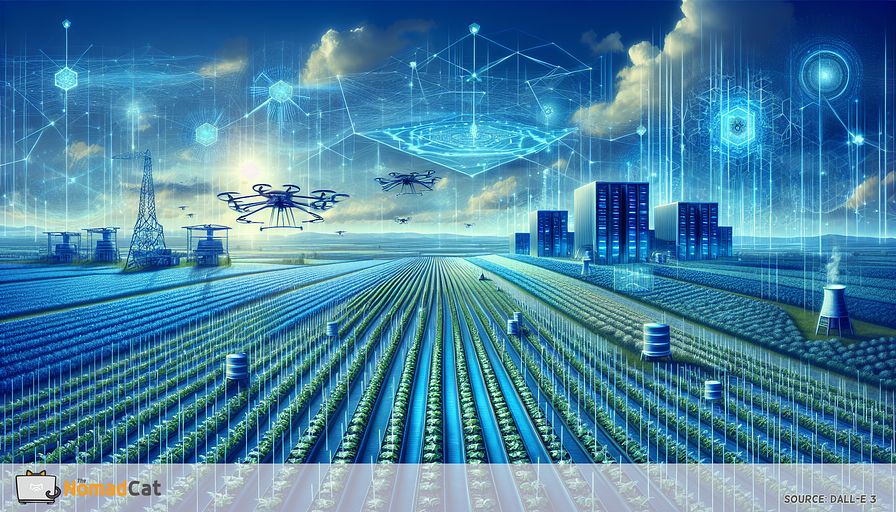Abstract:
With the global population on the rise and climate change posing significant threats to agricultural productivity, securing a stable food supply has never been more crucial. This article explores how technology, from artificial intelligence to blockchain and drones, is being utilized to revolutionize agriculture and ensure food security. By optimizing farming practices through precision agriculture, enhancing supply chain transparency with blockchain, and employing AI for crop monitoring and prediction, technological innovations are at the forefront of addressing food scarcity challenges. Moreover, these advancements promise not only to increase efficiency and yield but also to foster sustainable farming practices that are vital for the long-term health of our planet. For technology leaders and engineers, the intersection of tech and agriculture offers a fertile ground for innovation, underscoring the essential role of technology in solving some of the world's most pressing challenges.
Growing global population and climate change
With the global population expanding at a breakneck speed, and the accelerating impacts of climate change bearing down on agricultural systems, ensuring food stability has never been more crucial. As a Chief Technology Officer, I believe that technology holds the key to meeting these challenges head-on and revolutionizing agricultural productivity. It’s fascinating just how much technology is stepping up to elevate our ability to grow, distribute, and manage food resources more efficiently and sustainably.
Innovations are coming from all directions, bringing novel solutions to age-old problems. Precision agriculture, for instance, is transforming farming practices through the use of data analytics, sensors, and drones. This allows farmers to optimize their use of resources, improving crop yields while reducing environmental impact.
Blockchain technology is another game-changer, enhancing supply chain transparency in ways we couldn't have imagined a few years ago. It provides an immutable record of every transaction and movement within the supply chain, ensuring that every stakeholder has access to accurate and reliable information. This not only boosts trust but also helps in quickly identifying and addressing inefficiencies or contamination issues.
Moreover, artificial intelligence is proving to be an invaluable tool for crop monitoring and predicting yields. By analyzing vast amounts of data, AI can identify patterns and trends that might be invisible to the human eye. This leads to more informed decision-making and promotes sustainable agricultural practices. It's amazing how AI helps us tackle anything from pest control to water management, making farming smarter and more adaptive to changing conditions.
Stay tuned as we dig deeper into these technological innovations and explore how they are reshaping the agricultural landscape, ensuring food stability in the face of growing challenges. From precision agriculture to blockchain and AI, the possibilities are as exciting as they are impactful.
Precision agriculture and its impact on farming practices
Precision agriculture has rapidly become a cornerstone in the quest to enhance farming efficiency and sustainability. By leveraging cutting-edge technology, this approach allows farmers to make data-driven decisions that optimize every facet of agricultural practices.
The role of smart farming tools
One of the most exciting developments in precision agriculture is the use of smart farming tools, especially sensors and drones. These technologies play a critical role in monitoring various aspects of crop health and soil conditions.
- Sensors: Embedded in the soil, sensors collect real-time data on moisture levels, nutrient content, and temperature. This invaluable information enables farmers to tailor watering schedules and fertilizer applications, ensuring that resources are used precisely where and when they are needed.
- Drones: Offering a bird's-eye view, drones equipped with advanced imaging technology can scout large areas quickly. They capture detailed photographs and video footage, which can be analyzed to detect issues like pest infestations, nutrient deficiencies, or crop diseases before they become significant problems. This proactive approach helps in mitigating risks and optimizing crop health.
Increased efficiency and yield
The insights garnered from these smart tools significantly increase farming efficiency. By applying inputs such as water, pesticides, and fertilizers more accurately, excess use and waste are minimized. This not only cuts down operational costs but also protects the environment from overexploitation of resources.
Moreover, the precise application of these resources often leads to increased crop yields. Imagine being able to identify the perfect time to irrigate or apply fertilizers—such timely interventions can make a substantial difference in the health and productivity of crops. With higher yields, farmers can more easily meet the growing food demand.
Contributing to sustainable farming
Another significant advantage of precision agriculture is its support for sustainable farming practices. Traditional farming methods often involve blanket treatments over entire fields, leading to overuse of chemicals and water. By contrast, precision farming targets specific areas that need attention, minimizing externalities like chemical runoff, which can harm surrounding ecosystems.
This targeted approach also conserves natural resources. For instance, if soil moisture sensors reveal that only certain areas of a field need watering, farmers can avoid widespread irrigation. Over time, these small yet significant adjustments contribute to more sustainable and resilient agricultural systems.
Ensuring food stability
Ultimately, precision agriculture directly impacts food stability. By maximizing the efficiency of resource use and boosting yields while minimizing waste, it addresses some of the biggest challenges in modern farming. This innovative approach makes it possible to support a growing population without putting undue stress on the planet's ecosystems.
Through precision agriculture, we see a harmonious blend of technology and nature, where smart tools help us understand the intricacies of farming like never before. It's a compelling example of how technology not only solves problems but also opens up new pathways for more effective and sustainable agricultural practices.
Blockchain for enhancing supply chain transparency
One of the most intriguing uses of technology in agriculture today is blockchain. By creating a transparent and traceable supply chain, blockchain technology is fundamentally changing how we think about food safety and quality.
Ensuring food safety
Food safety is a critical issue that blockchain can significantly address. By providing an immutable ledger of every transaction, blockchain ensures that every step from farm to table is recorded transparently. This means we can trace the origin of any product, understand its journey, and verify its authenticity.
- Tracking origins: Having detailed records of a product's journey is invaluable. If contamination or another issue arises, blockchain can pinpoint precisely where and when it occurred, enabling swift action.
- Accurate data: Consumers can rely on the data provided by blockchain since it can't be altered. This trustworthiness is essential for ensuring that food safety standards are consistently met.
Reducing fraud
Another significant benefit of blockchain is its ability to reduce fraud in the agricultural supply chain. With every transaction and movement accounted for, the potential for tampering or misrepresentation is vastly diminished.
For instance, cases of mislabeling products can be significantly decreased. Farmers, distributors, and retailers must provide proof of origin and handling at each stage, making it challenging for deceptive practices to go unnoticed. This transparency ensures that only genuine and high-quality goods reach consumers.
Enabling quick and precise recalls
When it comes to food recalls, time is of the essence. Blockchain enables quick and precise recalls by maintaining an unbroken and detailed record of a product's lifecycle. This can be a game-changer for public health.
- Speed: Once a problem is identified, blockchain allows for rapid location of affected items. This speed can prevent harmful products from causing widespread issues.
- Precision: Detailed records mean that only the affected batches are recalled, minimizing waste and financial loss.
Securing consumer trust
At the end of the day, transparency is crucial for maintaining consumer trust and securing food quality. People want to know where their food comes from and how it's handled. Blockchain provides this visibility, reassuring consumers that their food is safe and of high quality.
By integrating blockchain, we offer unprecedented levels of transparency and traceability. This type of openness supports food security by ensuring that agricultural products are handled responsibly and can be trusted by all stakeholders, from farmers to consumers. Blockchain stands as a powerful tool that elevates the agricultural supply chain to new standards of integrity and reliability.
AI for crop monitoring, prediction, and sustainable practices
Artificial intelligence (AI) is nothing short of revolutionary when it comes to modernizing agricultural practices. By utilizing advanced algorithms and vast datasets, AI brings a level of precision and foresight that was previously unattainable. It’s truly exciting to witness how AI can transform crop monitoring, predict outcomes, and support sustainable farming methods.
Advanced crop monitoring
AI's ability to monitor crops goes beyond traditional methods. Through the integration of various sensors, cameras, and satellite images, AI systems can continuously track the health and growth of crops. This real-time information is critical for farmers.
- Real-time data: Sensors provide continuous updates on soil health, temperature, and moisture levels. This dynamic information allows for immediate adjustments, ensuring that crops receive exactly what they need at the right times.
- Image analysis: Drones and satellites capture detailed images of the fields, which AI algorithms then analyze. They can detect early signs of disease, pest infestations, or nutrient deficiencies, enabling timely interventions.
Predictive analytics for improved decision-making
One of the most powerful aspects of AI is its predictive capabilities. By analyzing data from a range of sources, AI can forecast various outcomes, helping farmers make informed decisions that maximize efficiency and yield.
- Yield predictions: Based on historical data and current conditions, AI models can predict crop yields with remarkable accuracy. This insight helps farmers plan their harvests and logistics more effectively.
- Weather forecasting: AI algorithms interpret weather patterns and predict future conditions. This allows farmers to prepare for extreme weather events, reducing potential damage to crops.
Optimizing irrigation and fertilization schedules
AI doesn't just collect data—it turns it into actionable insights. This is particularly valuable when it comes to managing irrigation and fertilization, key aspects of efficient farming.
- Water management: AI systems can determine the precise amount of water needed for different parts of a field, ensuring optimal irrigation. This reduces water waste and addresses the specific needs of each crop section.
- Fertilizer application: By analyzing soil data, AI can recommend tailored fertilizer schedules. This targeted approach ensures that nutrients are provided in the right amounts and at the right times, enhancing crop health and reducing chemical runoff.
Promoting sustainability
Sustainability is a cornerstone of modern agriculture, and AI plays a significant role in achieving it. By optimizing resource use and reducing waste, AI helps farmers adopt environmentally friendly practices that are essential for long-term productivity.
Applying resources more precisely prevents overuse and minimizes negative impacts on the environment. For example, using less water and fewer chemicals not only saves costs but also protects ecosystems from pollution. This is crucial for maintaining the health of our planet while meeting the growing food demands.
AI, with its unparalleled capabilities, supports sustainable farming in ways we could only dream of before. As AI continues to evolve, it promises even greater advancements, ensuring that agricultural practices keep pace with the challenges of our changing world.





